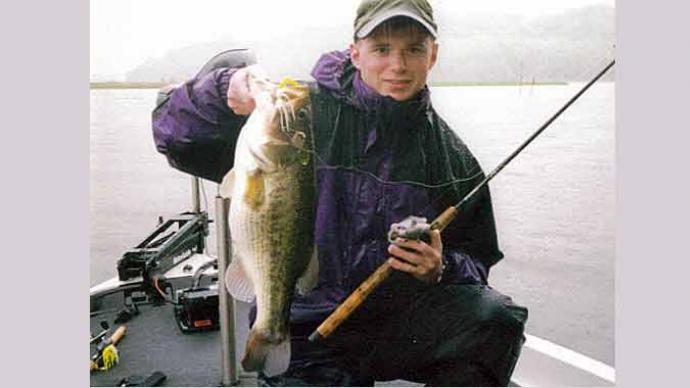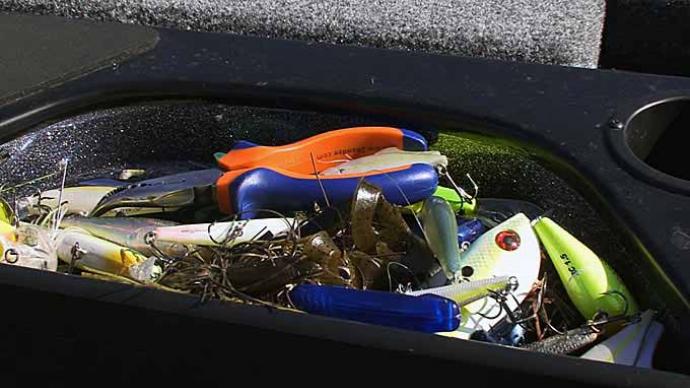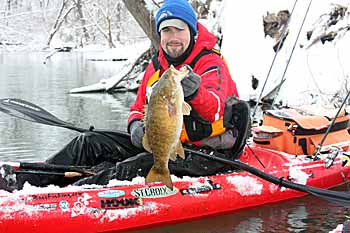
Each spring, I get a chuckle out of comments from people who know me only casually. “It’s almost fishing season, are you getting excited?” inquires a coworker. “Yep, I’m ready!” I reply without further explanation. I’m ready when the first red maple buds drop, and I’m ready at 4:30 a.m. on an early February Saturday morning when the forecast features freezing rain.
Winter river smallmouth fishing is not a hobby, it’s an affliction. I know of two fellow anglers who have died doing it, skunkings are routine, ice destroys your gear, and it often angers my wife when I go in bad weather. Despite all of this, it’s my favorite time to get after the smallmouth. Some day brain research will study the afflicted and find that anglers aren’t much different than those suffering from gambling addiction. They will see certain areas of our brain scans light up, watch serotonin or dopamine levels spike in the same way and understand what some of us have for years. It’s Saturday morning and we NEED to go fishing.
Some research done on gambling focuses on powerful brain activity following a win or reward when it’s not expected. Certainly the expectation to catch a fish after seven fruitless and cold hours on the water is low. But it does work. When it does, when you finally feel that signature THUMP! and swing on it, twenty-nine degrees quickly climbs to fifty-nine degrees. Your toes are no longer numb and you are ready for another seven hours. The high of catching smallmouth in those conditions is somehow higher. I’ve watched many novice smallmouth anglers set their sights on winter fishing. With determination, they have become more successful anglers, not only during the cold months but year-round as a result of the winter fishing experience. Here’s a primer for how to do it safer and more effectively.
Congregation
As I am writing this article my local water temperatures swing between the upper fifties and lower sixties. The trees are almost at peak foliage and an aggressive suspending jerkbait bite is just around the corner. It’s late October. This is when I scout for new winter habitat. The float I completed last Friday with my kids featured several stretches of low catch rates with two distinctive series of pools where we caught most of our fish. I took notice and made mental notes of landmarks to find them.
In the upcoming month and a half, I will replicate the float several times. The early November floats will feature a quick float down to each of these pools followed by hours of thoroughly dissecting each one. I tend to fish and float down the left bank, paddle back up to the top, then float down the right side, and finally the middle. I am looking for macro features of the pool's structure that provide a slowing of current at all river levels. The last four words of the previous sentence can’t be emphasized enough. More on that later.
By the time I complete the inaugural “Black Friday Float” at the end of November, I’ll have a good idea of the specific areas of the pools they will be tightening into. In winter fishing, once you find one, you’ve likely found a mess of them. This congregation starts in fall, but as December approaches, the group tightens. Float trips from here until late March mean making a beeline to these pools. No casts are made until you arrive on the scene.
Spot within the spot
When my alarm clock jolts me awake on cold January mornings to get up and go fishing, I am usually dreaming that I am already there. Visualizations help spur success. One specific spot that recurs in my winter fishing dreams is on the Rappahannock River, a smaller remote flow in central Virginia. The pool has great macro-current deflectors - ledges that swing a wide and deep flow away from one bank. It ends in a rock garden that provides a great place for them to move a short distance and spawn in May. But the spot I dream of placing my hair jig is a mound of gravel deposited by a notch in a steep bank. The water is deep all around it, but the top of the mound is only two feet deep. The late-day sun beats on it, spiking the water temperature in that tiny area.
I can’t tell you what to go out and look for in terms of the spot within the pool that makes it happen. It’s different in every winter pool. Sometimes it’s a big log that has become incorporated into the steep clay bank. Sometimes it’s an inside bend with three trash can-sized boulders just upstream of the deepest water in the pool. If you have put in your time in October and November, you are on a good winter pool. Take December and pound that pool until it gives up the spots within the spot.
Winter’s kitchen table
Where you find them at the end of three or four unusually warm winter days will be completely different from where they hunker down as ice forms on the surface. The days when I come home with an SD card full of photos of four-pounders are usually the former. That’s when they come shallow right next to deep water. Shallow water without current or wind pushing on it will warm up faster than deep water. Add in six hours of bright sun, and the water temperature really spikes. Stoneflies emerge darters that had been buried and motionless in the leaf matter start to venture out. The bass know that they can and must take advantage of the brief meal opportunity. Don’t bother with shallows that are more than seventy-five yards away from the most current-protected and deep part of the pool. Find the largest deep from one bank to the other section of the pool, look for any shallow sunbathed area right next to it, and work it hard.
Survive the ice-out flood
Years ago a friend took me on a very eye-opening ride on his jet boat. It was early March and the Susquehanna had just fallen below flood stage. Not only was the water the color of chocolate milk, but full-sized tree trunks were drifting downstream at us. We hit three spots and pounded fish at each one. I would drop the tube down into the narrow bank of calm water inches from shore and feel the line slide across the backs of fish. The trolling motor battery didn’t last long that day. We eventually used an anchor but had to keep an eye upstream for those tree trunks coming at us. Almost all of the water in the river was in motion. Plate ice collided with bridge pilings and parts of people’s riverside shacks floated by at a pace that had me questioning my sanity for being out there. I didn’t question my friend’s sanity though, he was nuts for sure.
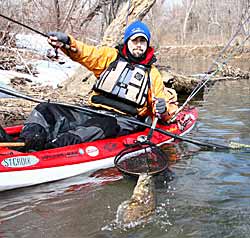
Crazy or not, my friend gave me one of the most important nuggets of knowledge on winter river smallmouth fishing: They choose places where they won’t get washed away regardless of the river level. One spot featured a creek mouth where water backed up in a calm notch. Another was the tail end of an island. A four-foot-wide patch of foam that sat completely still right there was the widest pad of still water we found that day. Another was along a bank that showed no reason for the slowed current. It had no point that diverted current away from it, but slack water was there, and so were the fish.
Going back to each of these places at normal and even low flow showed similar areas of sitting foam, but they had grown considerably in size. Lots of places afford them the ability to stay in place at low flow. Not all of them are good. Their metabolism slows to a pace where they seem to almost sleepwalk.
A friend described floating over a slumbering smallmouth on the upper Juniata in Pennsylvania. He spotted its tail sticking out from under a log. He stopped his kayak directly over it and watched it for minutes, then actually nudged it with his kayak paddle. He expected it to shoot off, but instead watched a very reluctant and slow swim away. They can’t react quickly or swim very far when the river comes up fast, as is the case in ice-out late winter floods. Pools that allow them to move short distances to areas of no current during a winter flood allow them to survive.
I wish I could tell you reliably what that looks like. I can’t, but I’ll provide some features that many of these pools and spots have in common. Steep banks are a huge plus. As the bank contour comes down steep, it usually continues in that direction, leading to deep water right next to the bank. The high bank affords them the short commute to get the heck out of the way of the river when it floods.
Another huge plus is depth. It’s not the kind of depth where you see a ledge that comes up to the surface then plunges to twelve feet deep that I’m talking about. There is no magic number of feet a pool must be to hold them in winter. But pools that have bank-to-bank depth, relative to the size of the river, hold a lot of volume.
Streamflow is measured in cubic feet per second. Think of slicing a river in a cross-section. Do that in a riffle, and there’s a fairly thin area where current passes through quickly. Do that in the deepest pool, and the cross-section is huge. The flow is slow, almost stopped. Each area has the same cubic feet per second, but the second one with a cross-section more like a lake than a stream is the preferred winter habitat.
Downsize Your Presentation

Imagine the frustration of fishing for eight hours without a bite then having that one hit, swinging on it and missing. Then imagine the frustration of reeling the tube that was hit only to find that all the tentacles were ripped off on the hook set. The fish chomped down on it a quarter-inch shy of getting the hook inside it’s mouth! That situation plays out more than most anglers realize. That frustration gave birth to my favorite winter lure: The Little Tube. At two inches long, many mistake the chubby little tube for a crappie lure. I’m not sure if their jaws are just too frozen shut to fit a larger bait inside, or if they have a preference for smaller forage in winter, but it will get you more bites in a day. When they do take it, they have to take the whole thing. I sell them at my website confidencebaits.net, along with the proper thin wire jig heads to match in 3/32nd and 1/8 oz. A color called Dark Chocolate is my favorite in winter.
The same “smaller profile” approach applies to hair jigs. Tie them sparse, and they draw more strikes. My favorite hair jig is one you can find a how-to tie video on YouTube. Search “strap jig” and you’ll find it. It utilizes a unique rigging of a #4 octopus hook, something that transcends the anglers need to feel the bite. It caught my coldest smallmouth at just over thirty-two degrees and I never felt the bite. I didn’t need to; the fish hooked themselves when they slowly swam off.
What Does It Feel Like? (Brace Yourself)
The biggest hurdle a winter bass angler has to overcome is confidence; knowing that it can and should happen. Before these anglers experience some success, they often second guess. “Was that a hit?” Knowing what a hit (better termed a “take”) feels like can be tough.
It depends on the day. My coldest day on the water last winter coincided with a snowstorm. I got three hits all day. One was from a carp, one I missed, and the other was a twenty-one-inch smallmouth. That smallmouth absolutely thumped the snot out of the Little Tube in thirty-four-degree water. More frequently the take feels just like when you slowly pull your lure off the bottom along with a leaf or two. It’s spongy, sort of a hovering feeling. Couple that sort of nebulous sensation with a kayak or canoe that is drifting ever so slightly and you can’t tell if the mushy throb you just felt was your boat moving, or your personal best smallmouth deciding if he likes the brand of scent you applied to your finesse jig. This one is huge, so read it more than once. Get yourself stationary.
I am not a huge fan of anchors, as they can really put you in a dangerous situation on the river, but if that’s the only way you can make yourself be completely stopped, do it. I much prefer to wedge my kayak on the bank, get out of the boat completely, run my YakAttack Park n Pole through a scupper hole (think parking brake for a kayak) or flop my leg over and have my heel dig into some shallow water. If you are drifting and casting, your ability to detect strikes is more than hampered. It’s almost gone. Get yourself stationary.
When they do “hit” in a manner that you can detect it as more than just your jig sliding onto the next stone, it is a single crisp sensation. It’s not always powerful, but it’s always crisp: “Ting! Tick! Smack! Thwack!” in increasing power. In comparison, pulling your tube slowly over gravel creates a series of dull thud-like vibrations. Getting used to what the jig sitting on the bottom does feel like can be the best way to recognize when the fish has picked it up. The spongy loose line tension of a fish holding the bait in its mouth may be all you get. When it feels different than the solid connection you had with the bait a moment ago, it’s time to set the hook.
Dialing up the sensitivity of your gear is also great advice. I use a 7’6” medium-fast St. Croix LegendXtreme spinning rod for fishing finesse jigs, Little Tubes and hair jigs in winter. I started out winter fishing with a forty-five-dollar house brand rod. I catch a lot more winter fish now. Sure, much of that is an experienced hand at work, but the hit recognition learning curve became much steeper once I invested in a top-end spinning rod. 15 lb test braid leading to a 10 lb test fluorocarbon leader helps too, due to minimal stretch transmitting every vibration down there.
Other Winter Baits
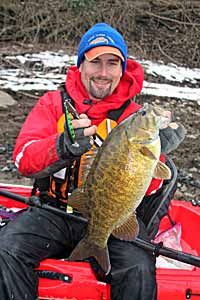
Bottom bouncing baits are the mainstay of winter fishing. A Confidence Baits Draggin’ Head, with a Floating Bird (snag-resistant jig coupled with small paddle tail grub) accounts for a lot of fish when they key on minnow forage. But during warming trends or rising water, you can catch them in the middle of the water column. A slow-rolled spinnerbait with size five or larger single Colorado blade moves slow enough for activated smallmouth to chase and pounce. I’ve caught them on a spinnerbait as cold as thirty-six degrees, so don’t ever count it out! Only reel as fast as you need to in order to feel that the blade is rotating. Feeling the head bash into rocks on the bottom every few feet means that you are being patient enough with it.
True five-pound river smallmouth are rare. I am blessed to live near a fishery that produces them. Most of the ones I’ve caught in recent years have been on a suspending jerkbait, namely a Lucky Craft Pointer 100. Two trips last February jump out in my mind as terrific winter suspending jerkbait days. The key to making them work is the pause. How long should you let it suspend? Forget that it’s an artificial bait. Slather some scent on it, and pretend that you have a creek chub on a circle hook out there.
How Long Do I Let It Set?
I’m not going to tell you how long, but the five-pounders I’ve caught on jerkbaits in February have come on pauses measured in minutes, not seconds. Apply the same approach to bottom bouncing baits like tubes and hair jigs. I fish with plenty of people who move their baits faster, and catch more fish than I do, but my experience with the largest fish has been that they want to come across it, not be coaxed into believing that it’s real with angler induced hops and jiggles. Need some convincing? Set a minnow trap during a warming trend. If you are lucky enough to catch a few craws or darters, you’ll see how slowly they cover distance.
My favorite footage from the “River Smallmouth Winter Patterns” DVD I am currently editing is of a crawfish that I scooped out of thirty-seven-degree water. He didn’t hibernate. He was found in leaf matter, moving very slowly, possibly searching for aquatic insects to munch on. The footage shows my Confidence Baits Finesse Jig N Craw next to this crawfish. I needed about thirty seconds of footage to show that he wasn’t dead, just moving very, very slowly. It drives the point home. Let it set for minutes, drag it slowly, three inches in thirty seconds, then let it set a few more minutes.
Winter Wear
I fish with lots of different people throughout the year. That list shrinks incredibly once it gets cold. Those who are willing to join me are going even if I am not. They all have one thing in common; proper winter wear. My buddy Juan Veruete put it best when he said, “It’s not like fishing tackle. You can’t scrimp to save a few bucks. You’ll die. The stuff that can get you through a submersion dry is mandatory. Get the best stuff, or just don’t winter fish.”
Dry suits will certainly accomplish that submersion test, but they aren’t the only option. My winter setup includes a Kokatat Whirlpool Bibs with relief zipper, a wrist and neck gasketed spray top to match, and a host of other layers of fleece for my top, bottom, hands and head. The waterproof relief zipper is my favorite part of what I am wearing. I unzip down there, pee, and get right back to fishing. I have friends who go with the waders and spray top method. When they need to relieve themselves, they have to take off a PFD (my friend who drowned while winter-fishing took his off,) take off a spray top or rain jacket, and pull down the waders to pee. You lose a lot of heat when you do all of this. And ladies, they have relief zippers designed for you too! It’s called a “drop seat” instead of “relief zipper”.
Every item of clothing that is on me is duplicated in a dry bag. Also in my dry bag is a fire starting kit that can start a fire in a thirty-three-degree downpour with a forty-mile-per-hour wind. You need to practice fire starting to figure out what works for you, but make sure that you have more than one ignition and initial fuel source. Steel wool, fire ribbon (think napalm in a toothpaste tube), waterproof matches, a Zippo lighter, several disposable lighters and an old magazine should get you started.
The “Umbles”
Hypothermia is horrible. You can’t hold a lighter in your hand long enough to get it lit (fumble). You can’t communicate with your buddy to tell him you’re messed up, you slur your words (mumble). You can’t walk a straight line and are likely to fall down (stumble). You’re more than irritable, and when your buddy tries to help you, you get nasty with him and shove him away (grumble). In other words, you resemble an angry drunk. You aren’t likely to acknowledge these signs in yourself, so always fish with a buddy, have a pact that when either of you display these signs, it’s time to be done with the trip.
Other Random Tricks and Tips
Ice forming on your guides can be minimized by spraying down your line on the spool with WD-40 or Reel Magic. Buy multiple sets of fleece fingerless gloves. When one set gets wet, swap it out. Putting a hand warmer packet in the back of each glove helps keep your hands warm enough to feel the subtle tap of a smallmouth, which will definitely warm you up all over. Leave an itinerary with someone not going on the trip. When your feet get cold, do what skiers do. From a standing position, hold onto two stationary objects, trees in the absence of ski poles, and swing your legs hard. The blood rushes down into your toes. Carry a thermos of hot water. Coffee or tea make you pee all day long, but holding the thermos cup of hot water then drinking it really helps.
Finding Warmer Water
This is covered in greater detail in the DVD, but certain sections of rivers are likely to be warmer than others. It doesn’t necessarily mean that fish move to these hot spots, but when one coincides with the type of winter pool structure outlined earlier, it’s the kind of place you think twice about taking anyone else to. Warm water discharges from power plants are often well known. The better parts of these areas are not immediately below the discharge. Find a good deep pool miles downstream, and you’ll avoid the crowds. You will also be fishing for a population of bass that aren’t killed by the thermal shock of a quick winter flood wiping out the band of warm water all at once. Truly “hot” winter water isn’t good for the fishery, and in many parts of the country it’s considered “thermal pollution” and is regulated against. Whether those regulations are enforced is another matter.

Tailrace fisheries support populations of trout in the summer by the cool middle layer of the reservoir coming through the turbines. Conversely in the early winter, the middle layer is warmer than the top layer, leading to say forty-three-degree water when ambient river temperatures in the region are in the mid-thirties. By mid-winter, the reservoirs chill down enough to not make this worthwhile, but in December and most of January, it’s worth a look.
Spring influences were a focus for me early in my winter fishing. I found that the headwaters of rivers like the Shenandoah and James in Virginia had water temperatures in the low to mid-forties when the lower sections cooled to the mid to upper thirties. The difference was an abundance of springs in the area. Look for regions that have caves or caverns as tourist attractions. The prevalence of karst geological activity coincides with many active springs and warmer rivers. I know of one smallmouth inhabited tributary in particular that never freezes up, when five miles away the Potomac River is locked up in ice.
Three or More Day Warming Trend
Being a weather nut is a symptom of cabin fever. It doesn’t change if I am going fishing on Saturday or not, but looking at the highs and lows, the forecasted cloud cover, and the prevailing wind seems to keep my cold winter evenings occupied. Doing so for years of winter fishing has taught me that periods of some of the best winter fishing has been either during a steady temperature trend or even better, one that is warming dramatically. The best of all situation features bright cloudless skies in the day followed by clouds moving in at night to retain the earth's sun gained warmth. It seems that each early January we have one of these four-day stretches; highs in the upper forties to mid-fifties with lows that stay in the low forties at night. One day won't spur activity. Several days in a row almost always do.
Wrap Up
Winter river smallmouth fishing isn’t something one usually aspires to. It comes naturally to those who obsess about river smallmouth the rest of the year and can’t really put it down once it’s cold. The afflicted weep when the river finally locks up in ice, and are back on the river as soon as it opens up again. They are in grave danger of death from the pursuit. Those who commit to it know how to be as safe as possible. Presentations are slow, down-sized, and deliberate, in locations that they have worked hard to find. The reward for enduring such harsh conditions? Photos of personal bests speak to that!
Jeff Little, co-owner of Confidence Baits, teaches river smallmouth and kayak fishing skills through his DVD series available at www.confidencebaits.net.


